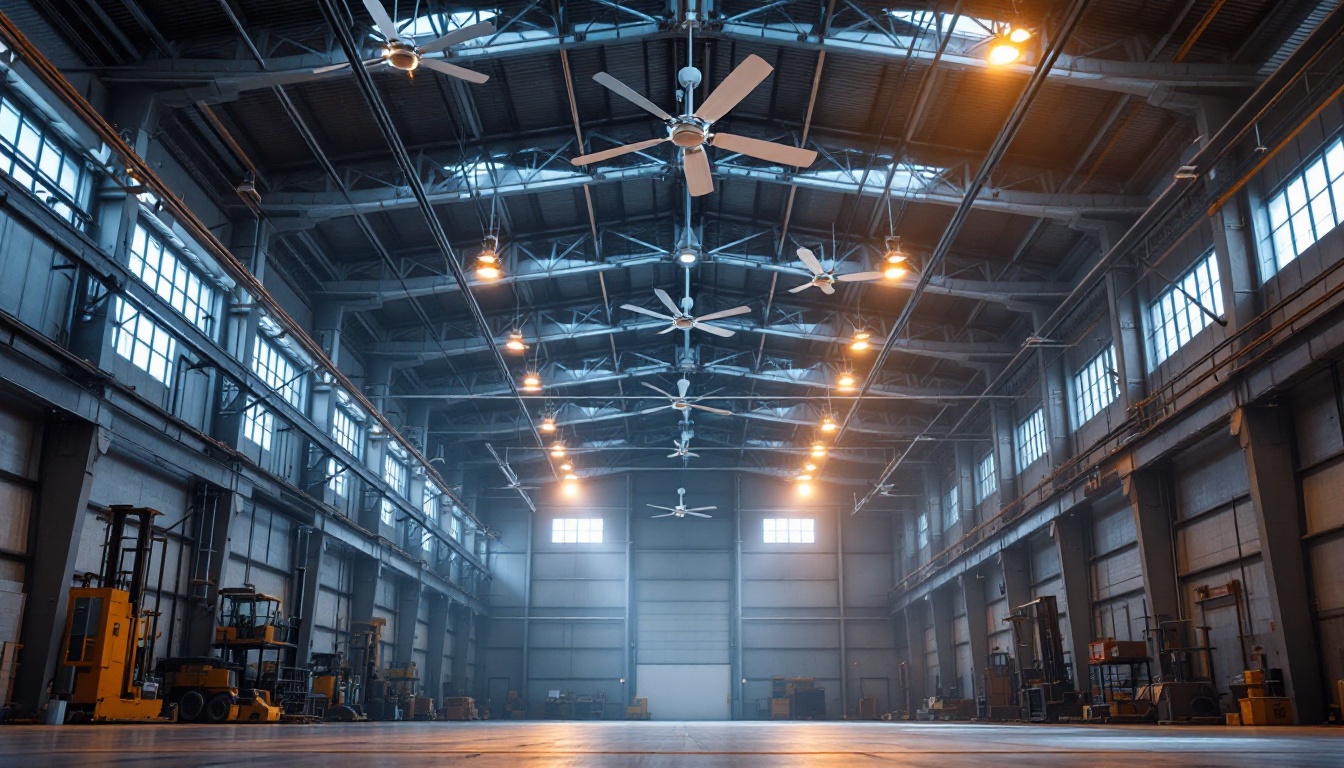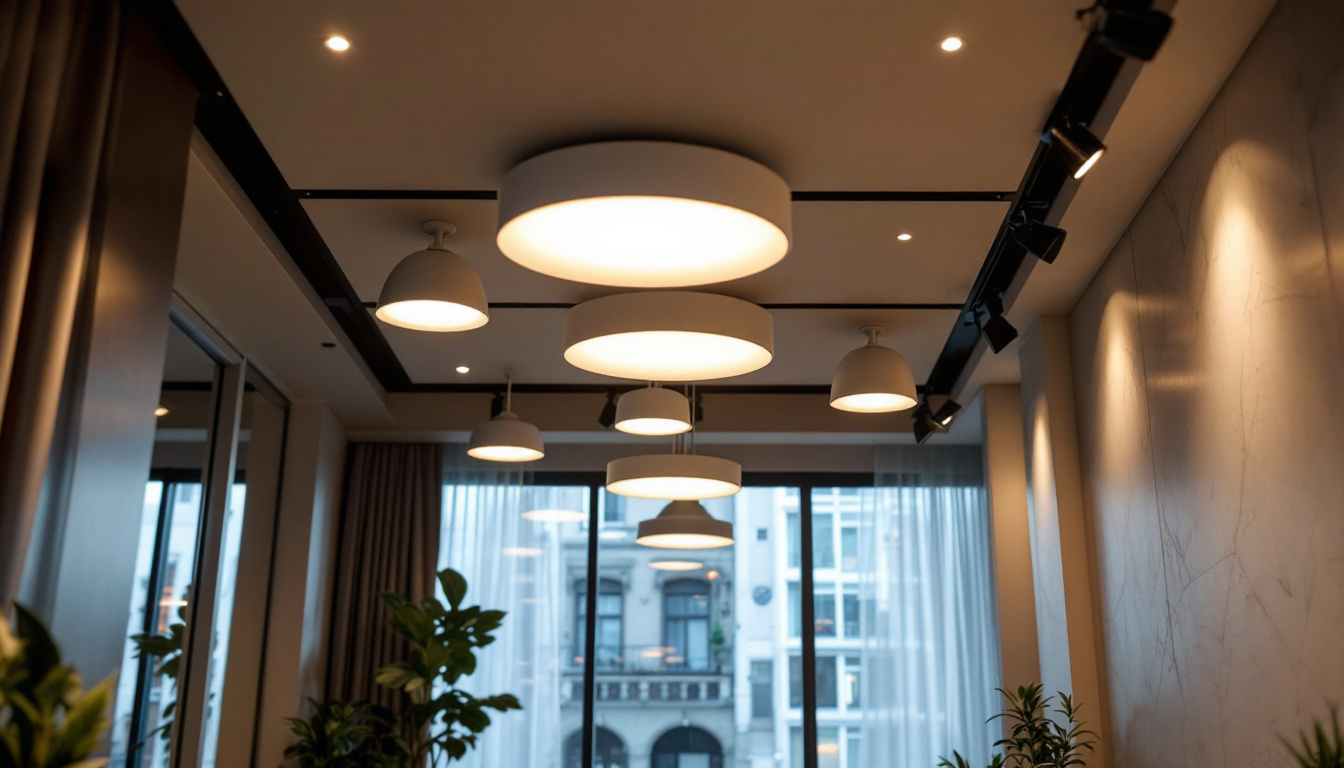
In the realm of warehouse operations, maintaining an optimal environment is crucial for productivity and efficiency. While lighting is often the primary focus for contractors, the importance of air circulation cannot be overlooked. Industrial ceiling fans play a significant role in enhancing comfort and efficiency in large spaces. This guide aims to provide lighting contractors with essential insights into selecting and installing industrial ceiling fans in warehouses.
Air circulation is a vital component of warehouse management. Stagnant air can lead to uncomfortable working conditions, affecting employee productivity and overall morale. Proper air movement helps regulate temperature, reduces humidity, and minimizes the risk of mold and mildew, which can be detrimental to stored goods. In addition to these factors, effective air circulation can also play a role in maintaining the integrity of sensitive materials, such as electronics or pharmaceuticals, which may require specific environmental conditions to ensure their longevity and effectiveness.
Moreover, effective air circulation complements lighting solutions by ensuring that light is evenly distributed throughout the space. This synergy not only enhances visibility but also contributes to a safer working environment. By preventing areas of shadow or glare, well-circulated air can help reduce the likelihood of accidents, allowing employees to navigate the warehouse more confidently. Furthermore, a well-ventilated space can also improve air quality, which is crucial for the health and well-being of the workforce, particularly in large facilities where dust and particulate matter can accumulate.
Industrial ceiling fans offer several advantages that make them an ideal choice for warehouses. Firstly, they are designed to operate efficiently in large spaces, providing a significant airflow without excessive energy consumption. This efficiency translates to lower utility costs, which is a crucial consideration for warehouse operations. Additionally, many modern industrial ceiling fans come equipped with energy-efficient motors and smart technology, allowing for further customization and control over airflow patterns, which can lead to even greater energy savings.
Secondly, these fans can help regulate temperature by creating a wind-chill effect, making it feel cooler in the summer and warmer in the winter. This temperature regulation can lead to substantial savings on heating and cooling costs, further enhancing the overall efficiency of the warehouse. Beyond just comfort, maintaining a stable temperature can also protect inventory from temperature fluctuations that could compromise quality, particularly for perishable goods or materials sensitive to heat. The ability to maintain a consistent environment can be a game-changer for businesses looking to optimize their storage and distribution processes.
When selecting industrial ceiling fans, it is essential to understand the various types available. The most common types include direct-drive fans, belt-driven fans, and high-velocity fans. Each type has its unique features and benefits, making it suitable for different warehouse applications. For instance, direct-drive fans are often favored in settings where low maintenance and quiet operation are essential, such as in facilities that operate around the clock or in close proximity to residential areas.
Belt-driven fans, on the other hand, are typically more powerful and can move larger volumes of air, making them suitable for expansive warehouse spaces. These fans are often used in environments with high ceilings, where their ability to push air over long distances can significantly improve overall circulation. High-velocity fans, in contrast, are perfect for spot cooling and can be easily repositioned as needed, making them ideal for temporary setups or areas that require targeted airflow. Understanding the specific needs of your warehouse can help in selecting the right type of fan to maximize efficiency and comfort throughout the space.
Selecting the right industrial ceiling fan involves several considerations. Understanding the specific needs of the warehouse is crucial to making an informed decision. Factors such as the size of the space, ceiling height, and the type of goods stored should all be taken into account.
The size and layout of the warehouse significantly influence the choice of ceiling fans. In larger spaces, multiple fans may be required to ensure adequate air circulation. It is essential to calculate the square footage of the area to determine the appropriate fan size and quantity.
Additionally, the layout of the warehouse, including the placement of shelves and equipment, can affect airflow. Fans should be strategically positioned to avoid obstructions and maximize air distribution throughout the space.
Ceiling height is another critical factor when selecting industrial ceiling fans. Fans need to be installed at a height that allows for optimal airflow without being obstructed by racking systems or other warehouse fixtures. Generally, the recommended height for fan installation is 10 to 14 feet above the floor.
For warehouses with higher ceilings, it may be necessary to use fans with longer downrods to ensure effective air movement. Proper installation height not only enhances performance but also ensures safety for employees working below.
As energy costs continue to rise, energy efficiency has become a top priority for warehouse operations. When selecting industrial ceiling fans, it is essential to consider their energy consumption. Look for fans that are ENERGY STAR certified or have high-efficiency motors, as these options can significantly reduce energy costs over time.
Sustainability is also a growing concern in the industry. Choosing fans made from eco-friendly materials and those that can be recycled at the end of their life cycle can contribute to a more sustainable warehouse operation.
Proper installation is crucial for maximizing the performance of industrial ceiling fans. Lighting contractors should be well-versed in the installation process to ensure that fans operate efficiently and safely.
Industrial ceiling fans can be mounted in various ways, including flush mount, downrod mount, and angled mount. The choice of mounting option depends on the ceiling height and the specific design of the fan. Flush mounts are suitable for lower ceilings, while downrod mounts are ideal for higher ceilings, allowing for better airflow.
Contractors should also consider the angle of installation. Fans installed at an angle can create a more effective airflow pattern, particularly in spaces with sloped ceilings.
Electrical requirements for industrial ceiling fans can vary significantly based on the fan size and motor type. It is essential to ensure that the electrical system can support the fan’s power needs. Contractors should consult local building codes and regulations to ensure compliance during installation.
Proper wiring is also critical for safety. Fans should be connected to a dedicated circuit to prevent overload and ensure reliable operation. Additionally, installing a wall switch or remote control can enhance user convenience and accessibility.
Regular maintenance is vital to ensure the longevity and efficiency of industrial ceiling fans. Lighting contractors should educate warehouse managers on the importance of routine inspections and maintenance practices.
Conducting routine inspections helps identify potential issues before they become significant problems. Contractors should recommend checking for loose screws, damaged blades, and any signs of wear and tear. Regular cleaning is also essential, as dust and debris can accumulate on the blades and hinder performance.
Additionally, checking the electrical connections and ensuring that the fan is operating at the correct speed can prevent unnecessary strain on the motor and prolong its lifespan.
Safety is paramount when it comes to industrial ceiling fans. Contractors should ensure that fans are installed securely and that all safety guidelines are followed. This includes ensuring that fans are properly anchored to the ceiling and that there is adequate clearance around the fan blades.
Furthermore, educating warehouse staff on safety practices, such as not standing directly beneath the fan while it is in operation, can help prevent accidents and injuries. Providing clear signage and instructions can also enhance safety awareness in the workplace.
Integrating industrial ceiling fans with lighting solutions can create a more cohesive and efficient environment in warehouses. The combination of effective lighting and air circulation not only enhances visibility but also improves overall comfort for employees.
When planning the layout of lighting fixtures and ceiling fans, it is essential to coordinate their placement to avoid creating dark spots or areas with inadequate airflow. Lighting contractors should consider the beam angle and distribution of light when positioning fixtures in relation to the fans.
Additionally, using dimmable lighting options can complement the effects of ceiling fans, allowing for adjustments based on the time of day or specific tasks being performed in the warehouse.
As technology continues to advance, integrating smart technology into warehouse operations has become increasingly popular. Smart ceiling fans equipped with sensors can automatically adjust their speed based on the temperature and occupancy levels in the space.
Furthermore, integrating lighting controls with ceiling fan operation can enhance energy efficiency. For instance, when the warehouse is unoccupied, both the lights and fans can be programmed to turn off, reducing energy consumption significantly.
Industrial ceiling fans are an invaluable addition to warehouse environments, providing essential air circulation that complements lighting solutions. By understanding the various types of fans, installation considerations, and maintenance practices, lighting contractors can enhance their service offerings and improve warehouse operations.
As the demand for energy-efficient and sustainable solutions continues to grow, selecting the right industrial ceiling fans can lead to significant cost savings and a more comfortable working environment. By integrating these fans with lighting systems, contractors can create a harmonious and efficient workspace that benefits both employees and the overall operation.
In conclusion, the role of industrial ceiling fans in warehouses should not be underestimated. With careful planning, selection, and installation, lighting contractors can contribute to creating a more productive and comfortable environment for all warehouse operations.
Ready to elevate your warehouse operations with superior air circulation and lighting solutions? Look no further than LumenWholesale, where we provide contractors with high-quality, spec-grade lighting products at unbeatable wholesale prices. Our commitment to cutting out the middleman means you get the best value without inflated markups, and our extensive selection is designed to meet the highest industry standards. With the added convenience of free shipping on bulk orders, LumenWholesale is your go-to source for reliable, high-performance lighting that enhances any project. Don’t settle for less—choose the perfect blend of quality, affordability, and convenience. Wholesale Lighting at the Best Value is just a click away.

Explore the transformative impact of LED strip lights in contemporary lighting solutions.

Discover how solar power landscape lighting is revolutionizing the industry for lighting contractors.

Discover how understanding recessed lighting sizes can enhance your projects and boost your business.

Illuminate your outdoor spaces with lamp post solar lights, the perfect blend of sustainability and style.